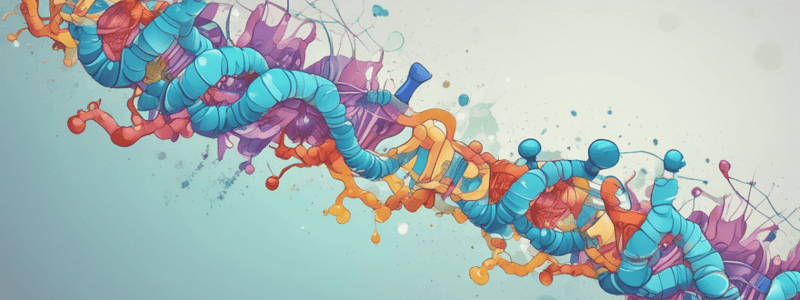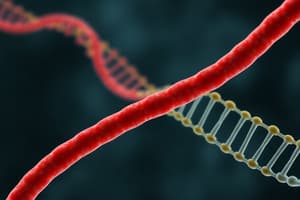Podcast
Questions and Answers
What is the primary reason for creating cDNA from mRNA?
What is the primary reason for creating cDNA from mRNA?
- To express prokaryotic proteins
- To clone RNA molecules
- To study the structure of introns
- To identify genes expressed in a particular cell type (correct)
What is the main advantage of using cDNA libraries over genomic DNA?
What is the main advantage of using cDNA libraries over genomic DNA?
- cDNA libraries contain more introns
- cDNA libraries are more difficult to sequence
- cDNA libraries are larger in size
- cDNA libraries represent the genes being expressed in a cell population (correct)
What is the enzyme used to produce cDNA from mRNA?
What is the enzyme used to produce cDNA from mRNA?
- DNA polymerase
- Reverse transcriptase (correct)
- Protease
- RNA polymerase
What is the primary application of DNA sequencing?
What is the primary application of DNA sequencing?
Why is it necessary to remove introns from mRNA?
Why is it necessary to remove introns from mRNA?
What is the primary difference between genomic DNA and cDNA?
What is the primary difference between genomic DNA and cDNA?
What is the primary purpose of DNA sequencing in the context of personalized medicine?
What is the primary purpose of DNA sequencing in the context of personalized medicine?
What is the role of DNA polymerase in the Sanger sequencing method?
What is the role of DNA polymerase in the Sanger sequencing method?
What is the characteristic feature of dideoxynucleotides that allows them to terminate DNA replication?
What is the characteristic feature of dideoxynucleotides that allows them to terminate DNA replication?
What determines the length of the fragments in dideoxynucleotide sequencing?
What determines the length of the fragments in dideoxynucleotide sequencing?
What is the result of incorporating a dideoxynucleotide into a growing DNA strand?
What is the result of incorporating a dideoxynucleotide into a growing DNA strand?
What is the purpose of using dideoxynucleotides in DNA sequencing?
What is the purpose of using dideoxynucleotides in DNA sequencing?
What is the name of the sequencing method devised by Sanger?
What is the name of the sequencing method devised by Sanger?
What is the difference between deoxynucleotides and dideoxynucleotides?
What is the difference between deoxynucleotides and dideoxynucleotides?
What is the primary purpose of using fluorescent markers in automated DNA sequencing?
What is the primary purpose of using fluorescent markers in automated DNA sequencing?
What is the average read length of fluorescent capillary dideoxy sequencing?
What is the average read length of fluorescent capillary dideoxy sequencing?
What is the primary difference between Next Generation Sequencing (NGS) and traditional dideoxy sequencing?
What is the primary difference between Next Generation Sequencing (NGS) and traditional dideoxy sequencing?
What was the original read length of radioactive dideoxy sequencing on gels?
What was the original read length of radioactive dideoxy sequencing on gels?
What is the estimated number of protein-coding genes in the human genome?
What is the estimated number of protein-coding genes in the human genome?
What is the purpose of the laser light in automated DNA sequencing?
What is the purpose of the laser light in automated DNA sequencing?
What is the primary advantage of Next Generation Sequencing (NGS) over traditional dideoxy sequencing?
What is the primary advantage of Next Generation Sequencing (NGS) over traditional dideoxy sequencing?
What is the average amount of DNA that can be sequenced per hour using fluorescent capillary dideoxy sequencing?
What is the average amount of DNA that can be sequenced per hour using fluorescent capillary dideoxy sequencing?
What is the temperature range for primer annealing in PCR?
What is the temperature range for primer annealing in PCR?
What is the purpose of the 96°C step in PCR?
What is the purpose of the 96°C step in PCR?
What is the maximum size of DNA fragments that can be amplified using PCR?
What is the maximum size of DNA fragments that can be amplified using PCR?
What is the primary application of PCR in genetic diagnosis?
What is the primary application of PCR in genetic diagnosis?
What is the purpose of PCR in forensic analysis?
What is the purpose of PCR in forensic analysis?
What is the primary application of DNA microarrays?
What is the primary application of DNA microarrays?
What is the temperature range for primer extension in PCR?
What is the temperature range for primer extension in PCR?
What is the primary application of PCR in molecular biology?
What is the primary application of PCR in molecular biology?
What is the primary purpose of comparative microarrays?
What is the primary purpose of comparative microarrays?
What does a yellow spot on a DNA microarray represent?
What does a yellow spot on a DNA microarray represent?
What is the purpose of labeling cDNA from sample 1 with green fluorescent dye?
What is the purpose of labeling cDNA from sample 1 with green fluorescent dye?
What is the significance of a red spot on a DNA microarray?
What is the significance of a red spot on a DNA microarray?
What is the advantage of using comparative microarrays over other microarray techniques?
What is the advantage of using comparative microarrays over other microarray techniques?
What is the relationship between relative fluorescent intensity and gene expression level?
What is the relationship between relative fluorescent intensity and gene expression level?
Flashcards are hidden until you start studying
Study Notes
mRNA and cDNA
- mRNA is produced when genes are transcribed, and it does not contain introns
- To express eukaryotic proteins or identify genes expressed in a particular cell type, we need to make DNA copies of the transcribed mRNA
- Complementary DNA (cDNA) is a DNA copy of mRNA, produced using an enzyme called reverse transcriptase
- cDNA libraries contain complementary DNA copies of the mRNAs present in a cell population and represent the genes being expressed in the population
cDNA Cloning
- cDNA cloning is used to make DNA copies of the transcribed mRNA
- cDNAs are used as the introns are removed, and the clone size is smaller
DNA Sequencing
- DNA sequencing allows us to determine the sequence of bases which can be used to predict the sequence of amino acids contained in the protein that the gene encodes
- DNA sequencing provides full characterization of genes within the genome
- DNA sequencing method devised by Sanger is the most common method (Nobel Prize 1980)
- Automated DNA sequencing uses four ddNTPs, each labeled with a unique fluorescent marker
- The DNA sequence fragments are separated on a capillary gel, and the fluorescence pattern produced shows the sequence of the DNA
Sequencing Technologies
- Sequencing technologies have advanced, allowing the ability to sequence larger amounts of DNA quicker
- Next-generation sequencing (NGS) uses sequential addition of nucleotides on microchips, short reads of 50-200bp, but very rapid, can sequence thousands to millions of DNA fragments per day
Genome Sequencing
- In 2003, the human genome was completely sequenced, and we have sequence information for all genes in the genome
- Current estimate is about 30,000 protein-coding genes
PCR
- PCR (Polymerase Chain Reaction) is a method used to amplify DNA fragments
- Amplified DNA fragments are separated by gel electrophoresis, and the PCR product size is equal to the amount of DNA between the primers
- PCR can amplify DNA fragments from tens of bases in length to 5kb
- Uses of PCR include amplifying whole genes or parts of genes from genomic DNA or cDNA for use in cloning and molecular analysis
- PCR can amplify specific regions of DNA from a variety of samples, e.g., specific gene in different individuals to perform genetic diagnosis
- PCR can amplify DNA from sources where DNA is limited, e.g., blood spots, fossils
Applications of PCR
- PCR is routinely used in screening of mutations involved in genetic disorders
- PCR is a key diagnostic methodology for the detection and identification of bacteria and viruses in humans
- Identify pathogenic bacteria in contaminated food
- PCR techniques are used to analyze samples from single cells
- PCR is used in forensics to identify individuals from body fluids left at a crime scene or in paternity testing
- PCR is used to check and confirm DNA constructs or transgenic animals
DNA Microarrays
- DNA microarrays or gene chips are modern devices that use nucleic acid hybridization to rapidly measure which genes are expressed in a tissue sample
- Comparative microarrays can be used to directly compare gene expression in two samples
- Can be used to compare gene expression in normal and diseased cells
Studying That Suits You
Use AI to generate personalized quizzes and flashcards to suit your learning preferences.




